Around 66% of e-commerce decision-makers plan to adopt a headless commerce strategy by the next year, and rightly so because the modern e-commerce demands flexibility and accuracy. Businesses require systems that enable smooth updates to customer-facing interfaces while maintaining back-end activities such as order processing and tax calculations. Headless commerce platforms perform this by decoupling the front end and back end, allowing enterprises to develop and optimize independently. This strategy is critical for delivering tailored shopping experiences while maintaining operational efficiency. Headless commerce helps businesses stay ahead of the competition by providing flexibility across workflows.
However, with so many platforms accessible, selecting the best one might be difficult. This blog dives into what is headless commerce and top headless commerce platforms, their distinct features, and how they might improve your e-commerce strategy. Let’s begin!
What is a headless commerce?
Headless commerce separates what customers see (the front end) from how the store actually works behind the scenes (the back end). While customers interact with product pages and the store’s design, the back end quietly handles all the technical work like processing orders, managing inventory, and calculating taxes.
Unlike traditional ecommerce that come with fixed layouts, headless commerce lets businesses create completely custom shopping experiences. This flexibility means companies can design custom ecommerce stores that work perfectly across all devices like phones, tablets, and computers using special connections called APIs. While some companies build their stores using platforms specifically made for headless commerce, others can adapt their existing traditional ecommerce stores to work in this separated way. This approach gives businesses more freedom to stand out and better serve their specific customer needs without being limited by pre-made templates.
Factors to consider while choosing a headless commerce platform
When selecting a headless commerce platform, it’s crucial to look beyond the marketing hype and carefully evaluate several key factors that will impact your business’s success. Here’s what you should consider:
User Interface Design
The platform should offer two kinds of user-friendly interfaces. First, the admin dashboard (back-end) should be clean, organized, and easy to navigate without a steep learning curve. Second, the customer-facing interface (front-end) must be equally intuitive since shoppers have little patience for complicated designs.
Integration Capabilities
Your platform should seamlessly connect with essential business tools, particularly your CRM and PIM systems. Check if it supports integrations with your existing tools or offers alternatives that meet your needs. The ability to connect with other business systems is crucial for smooth operations.
Learning Resources
Look for platforms that provide comprehensive learning support, including:
- Detailed knowledge base and tutorials
- Video guides for common tasks and troubleshooting
- Clear API documentation
- Active community forums where users share advice
- Regular training materials and updates
Customization Options
Since the main advantage of headless commerce is flexibility, ensure the platform offers deep customization capabilities. You should be able to:
- Independently modify both front-end and back-end
- Add and remove features as needed
- Connect with third-party tools and services
- Create unique shopping experiences
Customer Support Quality
Given that your online store is critical to your business, robust customer support is non-negotiable. The platform should offer:
- 24/7 support availability
- Multiple contact channels (live chat, phone, email)
- Quick response times for critical issues
- Knowledgeable support staff
- Emergency support for store outages
Before making your final decision, clearly define your personalization goals and ensure your chosen platform can support them. Remember that the right platform should not only meet your current needs but also accommodate your future growth plans.
Top 5 headless commerce platforms
According to reports, 47% of the businesses implementing headless commerce reported an improvement in ROI, indicating the financial benefits. To adopt this successful strategy business requires the best headless commerce platforms.
Here’s a brief look at 5 leading headless commerce platforms based on their user interface, integrations, customization ability, customer service, and pricing.
1. Adobe Commerce
Adobe Commerce is an open-source e-commerce platform known for its flexibility and scalability. It’s designed to support large enterprises and complex business models, providing powerful tools for managing everything from products to orders and customers.
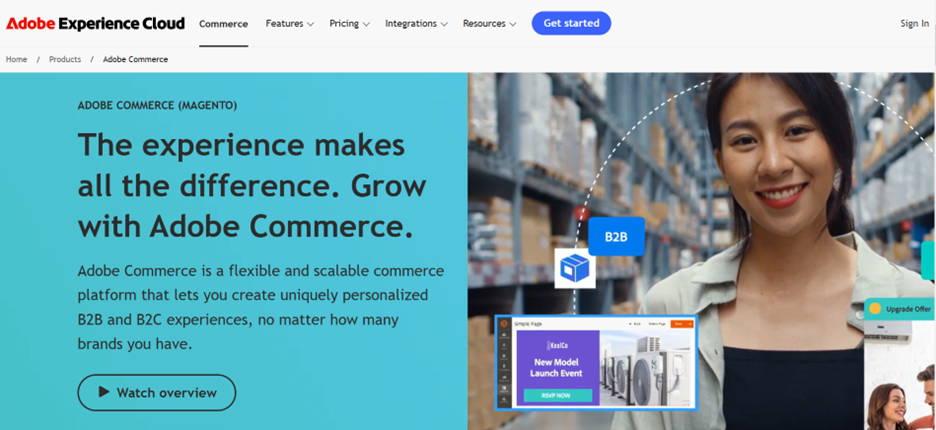
Source: Adobe Experience Cloud
- User Interface: Magento’s interface is robust but can be complex, requiring some technical expertise to navigate effectively.
- Integrations: Magento supports extensive integration capabilities through its API-first architecture, offering over 500 REST and GraphQL operations. This allows seamless connections to third-party services and tools while maintaining consistent performance. The flexibility of this setup enables businesses to integrate with various platforms effectively.
- Customization: As an open-source platform, Magento offers unparalleled flexibility, allowing for full customization of both front-end and back-end.
- Customer Service: Magento provides support through Adobe’s enterprise support options, with dedicated account managers for premium users.
- Price: Magento’s open-source version is free, but the Adobe Commerce (enterprise version) can be on the higher side, with pricing often tailored to the business needs.
2. BigCommerce
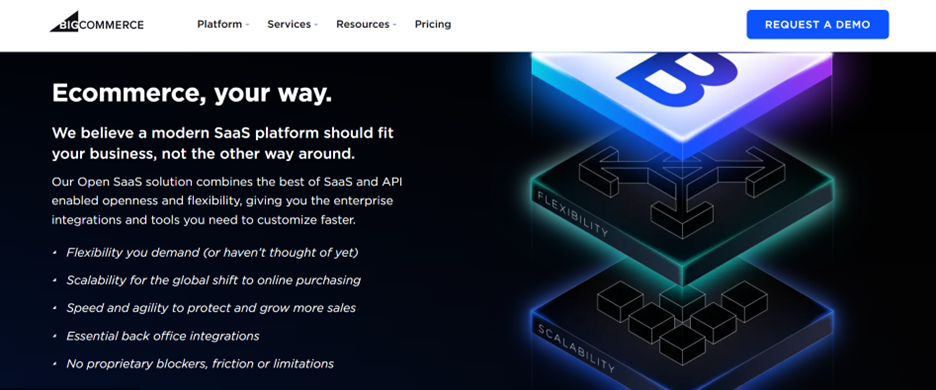
Source: BigCommerce
BigCommerce is a leading SaaS-based e-commerce platform designed for businesses of all sizes, offering both built-in features and headless capabilities for a flexible, scalable solution. It’s particularly favored for its ease of use and robust integrations.
- User Interface: BigCommerce provides a clean and modern UI with built-in templates and a user-friendly dashboard for managing products and orders.
- Integrations: BigCommerce supports extensive integrations through its API-first approach, allowing seamless connections with various third-party tools and services. It offers over 500 API endpoints that facilitate integration with CRM systems, payment gateways, and content management systems (CMS) like WordPress and Contentful.
- Customization: The platform allows for high levels of customization via APIs, though it may require some development skills for advanced features.
- Customer Service: Known for exceptional customer service, BigCommerce offers 24/7 support via live chat, phone, and email, alongside a detailed help center.
- Price: Pricing starts at $29.95/month, with different plans available based on features and scale.
3. CommerceTools
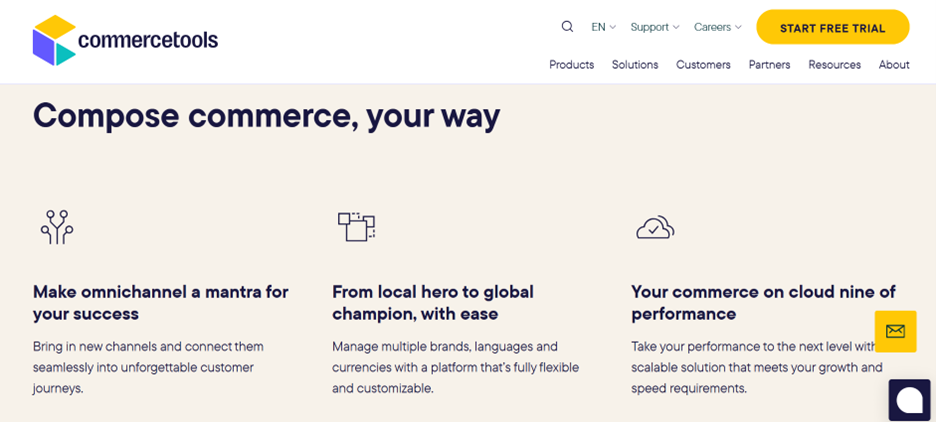
Source: CommerceTools
CommerceTools is a leading headless commerce platform that allows businesses to create highly customizable, omnichannel digital experiences. Its API-first architecture ensures maximum flexibility and scalability for complex e-commerce needs.
- User Interface: CommerceTools offers a flexible user interface, but as a more developer-focused platform, it may require some time to master for non-technical users.
- Integrations: CommerceTools supports extensive integrations via its API-first approach, with over 300 API endpoints available for seamless connections to third-party services. This flexibility allows businesses to integrate with various systems such as ERP, payment gateways, and content management systems.
- Customization: CommerceTools is known for its strong API-first approach, making it highly customizable for businesses that need unique solutions.
- Customer Service: While support is robust, it’s typically more suited for larger businesses with in-house development teams.
- Price: Pricing is flexible, based on the specific needs of the business, with enterprise-level plans that tend to be more expensive.
4. RackNap
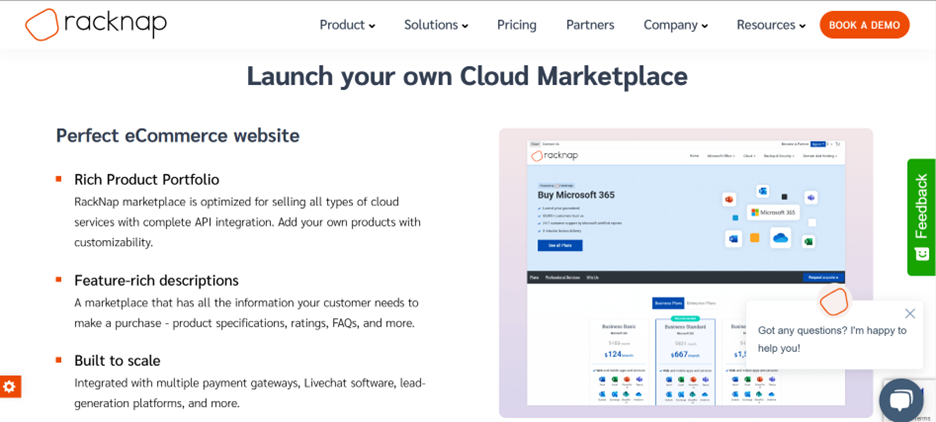
RackNap is a cloud service automation platform designed to support headless commerce, specifically catering to cloud service providers and marketplaces. It empowers you to offer a seamless and user-friendly shopping experience with its robust cloud and eCommerce marketplace solutions, helping you reduce the time and costs typically associated with discovering and purchasing products and services.
- User Interface: RackNap offers an intuitive interface with streamlined workflows for creating and managing storefronts, especially suited for service-based businesses.
- Integrations: RackNap offers a wide range of seamless integrations to optimize business operations. It supports popular payment gateways like PayPal, Razorpay, and Stripe for smooth transaction handling and integrates effortlessly with leading cloud providers such as AWS, Microsoft Azure, and Google Cloud. For hosting services, it integrates with Plesk and cPanel, while its automated billing and provisioning system make billing hassle free for subscription-based models.
Additionally, RackNap integrates with CRM tools like HubSpot to enhance customer relationship management, and connects with helpdesk platforms such as Freshdesk for efficient customer support. Its native analytics feature, along with integration with Google Analytics, provides detailed performance tracking, offering businesses a comprehensive and efficient platform for managing their operations.
- Customization: RackNap’s API-driven architecture enables high customization levels, particularly for businesses in the cloud and IT services sectors.
- Customer Service: RackNap provides solid customer support with dedicated help through email, live chat, and phone.
- Price: Pricing starts at competitive rates, with tailored plans based on business requirements and the scale of the marketplace.
5. Shopify
Shopify is a widely popular e-commerce platform known for its simplicity and ease of use. It enables businesses of all sizes to set up, manage, and scale their ecommerce stores. Shopify’s headless commerce approach allows greater flexibility in front-end development while leveraging its robust back-end infrastructure.
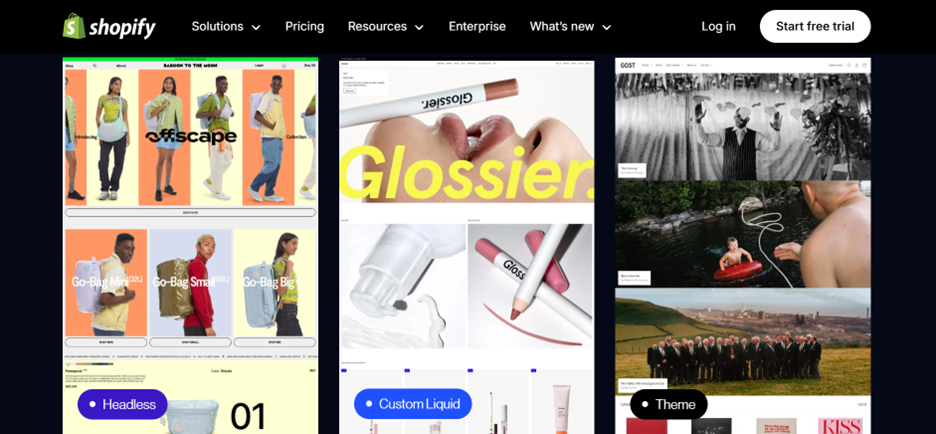
Source: Shopify.com
- User Interface: Shopify offers an intuitive, easy-to-use interface with a drag-and-drop functionality for creating stunning storefronts, making it perfect for entrepreneurs and small businesses.
- Integrations: With its Storefront API, Shopify offers robust integration capabilities that allow seamless connections to various third-party tools and services. This API-first approach supports the integration of payment gateways, marketing tools, and other essential services without compromising performance. Additionally, it enables omni channel selling, allowing brands to engage customers across multiple platforms.
- Customization: Shopify’s headless architecture provides extensive customization options, empowering merchants to create tailored shopping experiences that align with their brand identity. Businesses can optimize URL structures for better SEO and implement advanced personalization strategies based on user behavior.
- Customer Service: 24/7 customer support through live chat, phone, and email, with an extensive knowledge base and community forums.
- Price: Shopify’s pricing structure for headless commerce varies by plan—Basic, Shopify, Advanced, or Plus—making it accessible for businesses of all sizes. Pricing starts from $29/month, with various tiers offering additional features suited for different business needs.
Launch your business with RackNap’s readymade marketplace
No matter your role—Cloud Solution Provider (CSP), Managed Service Provider (MSP), Distributor, Independent Software Vendor (ISV), Internet Service Provider (ISP), Telecommunications Company (Telco), or Technology Vendor—RackNap is designed to meet your unique needs. Seamlessly integrate RackNap and deliver tailored experiences to your customers and unlock new growth opportunities with ease.
Contact us today for more information or drop a mail at touch@racknap.com for a personalized demo.
Disclaimer: The listing of headless commerce platforms is presented in alphabetical order and is not intended to imply any ranking or preference. The order in which platforms are listed should not be interpreted as a reflection of their quality, performance, or suitability for specific needs. All platforms are included based on their relevance to headless commerce, and we encourage users to carefully evaluate each option based on their unique requirements.
Read next: What are subscription bundles and how can it benefit your business?



